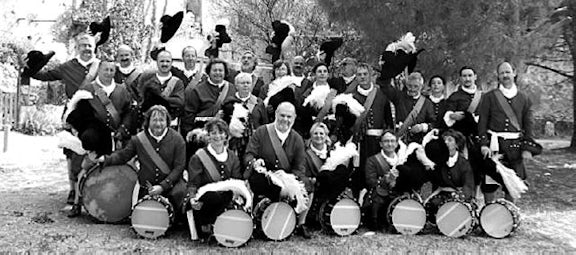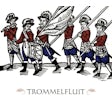Trommelfluit

Trommelfluit
Trommelfluit (DRUMSFIFE - Drums and fifergroup from Belgian Flanders) is a group that aims at keeping a form of historical music alive : the music of fifes and drums.
In the past centuries our region was a main field for war and conflict. If any good ever came out of this sad fact we can only refer to the music that accompanied these historic armies to the battlefield. From the sixteenth century onwards right up to the heyday of Napoleon their music was played on drums and small shrill-sounding traversal flutes called fifes. After all, when it came to volume, they had to rival with the considerable fracas of warfare.
About ten years ago members of the folkgroup "Kadril" took the initiative to revive the tradition of drums and fifes to enhance the Cat Pageant in Ypres. The necessary musicians were sought and found at the annual traditional folkmusic sessions in Gooik, organized by the V.Z.W. De Volksmuziekgilde (Non profit folkmusic guild).
Trommelfluit was born. A group of musicians limited to the use of fifes and drums. Several times a year they can be seen and heard blowing and drumming back to life their wonderful melodies. Naturally their preference goes to historic or traditional events : The Saint Jacob Pegeant in Brussels, the "Ros Beiaard Pageant" (a legendary gigantic horse ridden by four heroic children in Dendermonde), the traditional hop festivities in Faversham (England), ...A sight that is anachronistic to our day and age but makes the spectators and listeners feel : yes, this is the music of the old, sumptuous pageants, parades, pomp and circumstance, proper to our region. This is the music, that as no other, fits in perfectly with the variety of styles that we discover in our Flemish monuments, buildings and market squares.
THE MUSIC
The music played by Trommelfluit was discovered in old handwritten sheetmusic dating back to the seventeenth and eighteenth century. The titles of the melodies and marches refer to the rulers, men of arms or guilds from this era : De March der Gezworenen uit Brussel (The March of The Men of Oath from Brussels), De March van den Prins van Luyck (The March of the Prince of Luyck), Den Conincxvogel van Sint-Barbara uit Diest (The King's Bird of St. Barbara from Diest), De March van de gilde "Vrede Best" uit St.-Niklaas (the March of the guild "Peace is Best" from St. Niklaas, ... are all on the programme.
The drumming to these marches was rather a problem as we have no real drumtradition left in our region. It was lost due to the infiltration of American styled drumbands. Fortunately the Walloon region managed to keep its drumtradition alive so that their drummers could help us out.
THE COSTUME
1670 is the year in which the first uniforms came into use in the French army. Before, everybody dressed according to personal whim and taste, or according to what the nobility, who owned the regiments, ordered them to wear. The first uniforms are very similar to what the average civilian wore : a coat, called a "justaucorps", a pair of kneelenght breeches and a broadrimmed hat.
The costume of Trommelfluit is a copy of the Swiss Regiment De Salis. It was with this regiment that the French King, Louis the XIVth. entered Ypres after a ten day siege. A few days before he'd had a close shave being almost killed when a civilian from Ypres - Nicolaas Hoedt - shot a cannonball from the city under siege into the King's sleeping quarters. The king escaped without injury but eighteen of his personal guards lost their lives. Every three years this historic event is commemorated in the Ypres Cat Pageant which shows the giant Nicolaas the Cannoneer, accompanied by Trommelfluit.
Research in the military museum allowed us to copy the uniform of the Swiss De Salis regiment as authentically as possible. For the Swiss serving in the French army, the "justaucorps" had a typical red colour. These troops were famous or rather notorious and during battle there opponents compared them to a sturdy red brick wall impossible to crack... The different regimental companies could be distinguished by the amount of buttons on sleeves and pockets and by their colour. Those of the De Salis regiment were silver and metallic. On the upturned sleeves there were three buttons and on the pockets five.
The large widerimmed hats came from a "sombreria" or Spanish habberdasher from Santiago de Compostela. The ostrich feathers were brought directly from South Africa by the group Kadril after a concert tour there.
Weapons consisted of a sabre and musket. Out of safety precautions Trommelfluit chose not to include these... The gunpowder for the muskets was kept in twelve wooden flasks attached to a bandolier about four inches wide worn crosswise over the shoulders : the bandoulière. Due to their amount the flasks were sometimes called "the twelve apostles". To the "bandoulières" the group also attached exact replicas of the bullet bags.
Apart from the headgear all parts of the uniform were homemade by the members of the group : the thirty "justaucorps" and kneelength breeches, the thirty leather bandoliers with their bullet bags and more than two hundred powder flasks !
THE BANNER
The banner of the De Salis Regiment was also reconstructed. Like all French flags in those days it bore the typical white cross. White being the colour for France as Orange was characteristic for Holland. In the four quarter parts of the flag one sees 4 wavy flames alternately in yellow and black. Thus the banner is nothing more than a historic copy of the original and has no up-to-date or ideological meaning. Trommelfluit has done this intentionally because in the past so many who followed a "banner" were later on bitterly deceived in what they had once believed in. Unfortunately this still applies to our own day and age.
When those who are curious and try to find some hidden meaning in our banner keep asking us : "Where are you from ?", we have to leave the question more or less unanswered. We're from everywhere and every era. Our unity is forged by music of traditional origin and our feeling of togetherness.


